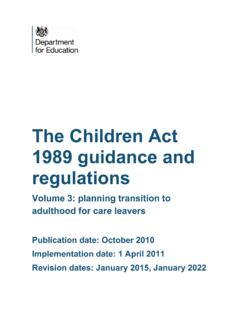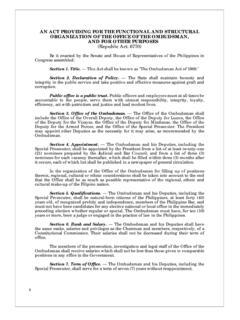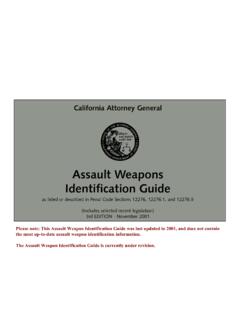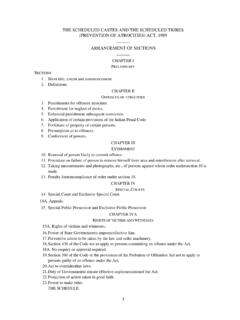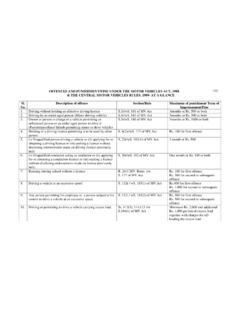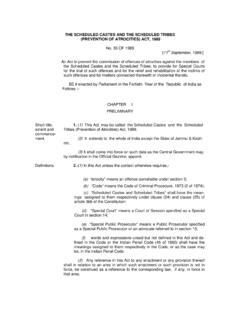Transcription of The Children Act 1989 guidance and regulations - GOV.UK
1 The Children Act 1989 guidance and regulations Volume 2: care planning, placement and case review July 2021 2 Contents Summary 5 About this guidance 5 What legislation does this guidance refer to? 5 Who is this guidance for? 5 Main points 7 1. Introduction 8 The Children Act 1989: key principles 9 The UN Convention and the European Convention on Human Rights 10 The child s wishes and feelings 10 Corporate parenting and multi-agency involvement 11 The legal context 12 The looked after child 12 Overview of the legislation and regulations in relation to this guidance 15 2. Care Planning 19 The purpose of care planning and review 19 Permanence planning 19 The relationship between the care plan and other plans 21 Arrangements for looking after a child 28 Arrangements for contact 38 The role of the IRO in improved care planning 43 3.
2 Placement 47 Placement under the 1989 act 47 The placement decision for an individual child 48 Provision for different types of placement 62 Temporary approval of a connected person 68 Placement of Children with foster carers who are also approved prospective adopters 80 Placement plans 88 Types of decision 94 3 Requirements to promote a strategic approach to placements 105 Independent visitors 107 4. Case review 115 Policy on reviews 115 Timing of reviews 115 Links with other reviews 117 Preparation 117 The conduct of the review 117 Duties of the IRO in the review process 124 5. Ceasing to look after a child 128 Children accommodated under section 20 128 Considering ceasing to look after a child 129 Eligible Children transition to adulthood 130 6. Short Breaks 136 The legal basis for short breaks 136 Care planning, placement and review in relation to a planned series of short breaks 141 Planning requirements where regulation 48 applies 141 Visits where regulation 48 applies 143 Review requirements 143 The role of the independent reviewing officer 144 7.
3 Case records 145 Establishing the child s record 145 Retention and safekeeping 146 Access and confidentiality 147 8. Looked after Children in contact with youth justice services 148 Responsibilities 148 Looked after Children who have been arrested 149 Looked after Children charged with an offence 150 Children not currently looked after 150 Children who are remanded 151 Looked after Children who are convicted 160 4 Requirements following sentence 161 Custodial sentences 163 Annex 1: The statutory framework for care planning 173 Annex 2: Overview of the care planning, placement and review process 175 Annex 3: Dimensions of developmental need 176 Health 176 Education 177 Specific guidance on care planning arrangements in relation to education is set out at paragraphs to Family and social relationships 178 Emotional and behavioural development 179 Identity 180 Social presentation 181 Self-care skills 181 Annex 4.
4 Suggested information for discussion between authorities when planning distant placements 183 Basic information about the child 183 Plans for the child s care 183 Services to support the child 184 Annex 5: Delegating authority to foster carers things you need to know 185 Annex 6: A model for joint planning and practice 187 Annex 7: Changes to care status as a result of criminal justice decisions 188 Further information 190 Useful resources and external organisations 190 Other relevant departmental advice and statutory guidance 190 Other departmental resources 190 5 Summary About this guidance This is statutory guidance from the Department for Education. It is issued as guidance under section 7 of the Local Authority Social Services Act 1970 which requires local authorities in exercising their social services functions, to act under the general guidance of the Secretary of State.
5 This guidance should be complied with by local authorities when exercising these functions, unless local circumstances indicate exceptional reasons that justify a variation. Volume 2 of the Children Act 1989 guidance and regulations provides guidance , primarily addressed to local authorities and their staff in England, about their functions under Part 3 of the Children Act 1989. What legislation does this guidance refer to? The Children Act 1989 The Care Planning, Placement and Case Review (England) regulations 2010 as amended by: o The Care Planning, Placement and Case Review and Fostering Services (Miscellaneous Amendments) regulations 2013; o Adoption and Care Planning (Miscellaneous Amendments) regulations 2014; o The Care Planning and Fostering (Miscellaneous Amendments) regulations 2015; o The Care Planning, Placement and Case Review (England) (Amendment) regulations 2021 The Legal Aid, Sentencing and Punishment of Offenders Act 2012 The Adoption Agencies regulations 2005 (as amended by the Adoption and Care Planning (Miscellaneous Amendments) regulations 2014 Who is this guidance for?)
6 This guidance is for: Local authorities Children s services social workers; 6 Supervising social workers; Frontline managers who have particular responsibilities in relation to looked after Children ; Lead members in local authorities; Directors of Children s services; Managers of services for looked after Children ; Managers and staff of services to care leavers; Commissioners of placements and other services for looked after Children ; Virtual School Heads; Independent Reviewing Officers; Youth Offending Team managers and workers; Governors, Directors and Registered Managers of youth detention accommodation; Staff, including professionals providing education and health care, in youth detention accommodation; Social workers based in Young Offender Institutions; Nominated officers; Officers who are responsible for carrying out the assessment and approval of foster carers who are already approved prospective adopters; Adoption agencies; It will also be relevant to: Children s Trust partner agencies; Providers of services to looked after Children , including private, voluntary and public sector providers; Foster carers and residential workers; Fostering agencies; Children s services partner agencies with responsibilities for supporting looked after Children including professionals in schools, health services and youth justice services.
7 Looked-after Children , care leavers and their families may also have an interest. 7 Main points This guidance updates and consolidates The Children Act 1989 guidance and regulations , Volume 2: Care Planning, Placement and Case Review documents published in March 2010. It now includes information contained in the following updates and supplements: Delegation of Authority: Amendments to the Children Act 1989 guidance and regulations July 2013 Looked-after Children : contact with siblings February 2014 Looked-after Children and youth justice: Application of the Care Planning, Placement and Case Review (England) regulations 2010 to looked-after Children in contact with youth justice services April 2014 Early permanence placements and approval of prospective adopters as foster carers: Statutory guidance for local authorities and adoption agencies July 2014 Out of authority placements of looked-after Children July 2014 Permanence, long-term foster placements and ceasing to look after a child March 2015 8 1.
8 Introduction Looked after Children deserve the best experiences in life, from excellent parenting which promotes good health and educational attainment, to a wide range of opportunities to develop their talents and skills in order to have an enjoyable childhood and successful adult life. Stable placements, good health and support during transition are all essential elements, but Children will only achieve their potential through the ambition and high expectation of all those involved in their lives. This guidance sets out the functions and responsibilities of local authorities and partner agencies under Part 3 of the Children Act 1989 ( the 1989 act ), which concerns the provision of local authority support for Children and families. In particular it describes how local authorities should carry out their responsibilities in relation to care planning, placement and case review for looked after Children .
9 These responsibilities are designed to support the local authority in its primary duty set out in section 22(3) of the 1989 act to safeguard and promote the welfare of the looked after child and to act as good corporate parents to enable each looked after child to achieve his/her full potential in life. This guidance accompanies the Care Planning, Placement and Case Review (England) regulations 2010 ( 2010 regulations ), which bring together in a single set of regulations those duties which are at the heart of effective corporate parenting to improve the outcomes of looked after Children , namely: placing the child at the centre of the work; effective care planning; ensuring that a child or young person is provided with accommodation which meets his/her needs; and ensuring that an effective review is conducted of the child s case within the specified timescales.
10 This guidance is issued as part of a suite of statutory guidance which, together with the 2010 regulations , set out how local authorities should carry out the full range of responsibilities in relation to care planning, placement and review for looked after Children . Annex 1 shows how these and other documents fit together within an overall framework, the aim of which is to provide looked after Children with the most appropriate placement to meet their needs and improve their outcomes. 9 The Children Act 1989: key principles A key principle of the 1989 act is that Children are best looked after within their families, with their parents playing a full part in their lives, unless compulsory intervention in family life is necessary. That principle is reflected in: the concept of parental responsibility; the ability of unmarried fathers to share that responsibility by agreement with the mother, by joint registration at birth or by court order; the local authority s functions to provide services which support Children and their families; the local authority s duty to return a looked after child to his/her family unless this is against his/her interests; and the local authority s duty, unless it is not reasonably practicable or consistent with his/her welfare, to endeavour to promote contact between a looked after child and his/her parents or others.










